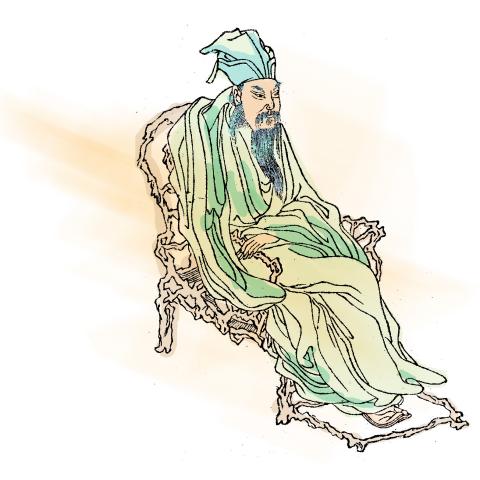Chinese practice
胸有成竹
to have fully-formed bamboo in the mind

Photo: Wikimedia Commons
照片:維基共享資源
(xiong1 you3 cheng2 zhu2)
蘇軾(西元一○三七~一一○一年)又名蘇東坡,為北宋詩人、書法家及政治家。他在〈文與可畫篔簹谷偃竹記〉(一○七九年作)中寫道:
「故畫竹,必先得成竹於胸中,執筆熟視,乃見其所欲畫者,急起從之,振筆直遂,以追其所見,如兔起鶻落,少縱即逝矣。」(所以說畫竹,心裡一定先要有完整的竹子,拿著筆凝神而視,就能看到自己心裡想要畫的竹子了。這時快速地跟著自己的所見去畫,去捕捉看到的形象,就像兔子躍起、鶻鳥降落一樣迅速。)
蘇軾此文標題所提到的文與可,即蘇軾的朋友及表兄文同(西元一○一九~一○七九年),他是著名學者、藝術家及書法家,今有繪畫作品《墨竹》傳世,享有盛名。據載,文同對竹子有極精到的了解和知識:他居於竹林中,閒暇時便在竹林間漫步,仔細觀察竹子的生長方式、竹葉的形狀和姿態、竹葉與細枝莖幹的交錯等細節,甚至竹筍是如何生長。一回到家,他就立刻用筆墨把所觀察到的畫在紙上,把竹子的樣貌極為忠實地演繹出來──正如蘇軾所寫的,文同「成竹於胸中」(在心中形成竹子的全貌)──此即為成語「胸有成竹」的由來,意為對要做的事有充分的準備。
英文中有一個說法「winging it」,其概念(至少是表面上的概念)和「胸有成竹」恰恰相反。
此處的wing一字,並非指鳥或飛機的翼或建築的廂房,而是指劇場舞台兩旁觀眾看不到的區域。若演員因種種原因沒把台詞記牢,他們就會站在舞台側翼臨時抱佛腳,或是就直接上台,然後由他人在舞臺側翼幫忙提示台詞。
一八八五年的英國《舞臺》雜誌將wing這個動詞定義如下:
「to wing指的是不知道台詞卻仍能演出該角色。之所以使用wing這個字,是因為藝人常需要提詞人的幫助,提詞人藏身之處便是在布景後面或在舞台側翼。」
雖然「winging it」這個說法源自英國,但把它當作成語來用的可能是美國人──美國《君子》雜誌在一九五九年將「to wing」定義為「做事沒有準備」。
我們可能事前只做了一點點準備,就去「wing」一場簡報、面試或授課。但是,如同《舞台》雜誌的定義所暗示的,即使沒什麼準備,表演者憑其熟練的技巧及一定的經驗,還是能夠順利完成任務。
(台北時報林俐凱譯)
她已經準備了很久,面對這場考試可說是胸有成竹、信心滿滿。
(She had been studying for this exam for ages, and was throughly prepared and brimming with confidence.)
教練這次對於球隊晉級胸有成竹,最後果然不負眾望旗開得勝。
(The coach had thoroughly prepared the team, and the final result was just as he’d hoped: They were victorious.)
英文練習
to wing it
The Northern Song Dynasty poet, calligrapher and statesman Su Shi (1037 – 1101), also known as Su Dongpo, wrote, in his 1079 work On Wen Yuke Painting the Bamboo Grove of Yun Dang Valley, the following:
“When painting bamboo, it is imperative to first have the bamboo fully formed in one’s mind, that, in wielding the brush, one can previsualize what it is one intends to paint. The execution is immediate; the brush is instantaneously placed on the silk to render there what has been previsualized, as a falcon swooping the moment the hare emerges, where the moment is lost with the slightest hesitation.”
The Wen Yuke of the title was Su’s friend and cousin, Wen Tong (1019–1079), a renowned scholar, artist and calligrapher, famous now for his work Bamboo in Monochrome Ink. It was said that Wen had an intimate knowledge and understanding of bamboo: That he lived within a bamboo grove, that in his spare time he would stroll among the bamboo, observing the way it grew, the shape and position of the leaves and the minutiae of their interaction with the twigs and stalks, and even how the shoots grew. On returning to his house, he would immediately commit his observations to paper with his ink brush, painting incredibly faithful renditions of bamboo. As Su wrote, Wen had 成竹於胸中 (the bamboo fully formed in his mind), giving us the idiom 胸有成竹, meaning to approach a task thoroughly prepared.
In English, there is the concept of “winging it,” which – at least on its surface – means the opposite of 胸有成竹.
The wing here refers not to that of a bird, plane or building, but the area on either side of the stage in the theater that is out of sight. When actors, for whatever reason, had not committed their lines to memory, they would stand in the wings quickly preparing them, or go on stage and be prompted from the wings.
In an 1885 edition of the British magazine The Stage, the verb was defined thus:
“’To wing’... indicates the capacity to play a role without knowing the text, and the word itself came into use from the fact that the artiste frequently received the assistance of a special prompter, who... stood... screened by a piece of the scenery or a wing.”
Despite the British theatrical origins of “winging it,” it may have been the Americans that made it idiomatic, with Esquire defining “to wing” in 1959 as “to do something without preparation.”
We might “wing” a presentation, interview or class by going into the situation with little prior preparation. However, as the Stage definition indicates, even though there is no preparation as such, there is a suggestion of a learned skill or a certain degree of experience on the part of the person “winging it” to ensure their success.
(Paul Cooper, Taipei Times)
This speech could define your career. It’s not something you should just wing.
(這場演說對你的職涯有決定性影響,不是你可以臨時打鴨子上架的。)
Let’s not book a hotel. Can’t we just turn up and wing it?
(還是不要先訂房好了,我們難道不能到那裡再找旅館嗎?)

Autism spectrum disorder (ASD) is a neurological and developmental condition marked by disruptions in brain-signaling that causes people to behave, communicate, interact and learn in atypical ways. Autism diagnoses in the US have increased significantly since 2000, intensifying public concern over what might contribute to its prevalence. Here is what you need to know. HOW IS AUTISM DIAGNOSED? There are no objective tools for diagnosing autism, such as blood tests or brain scans. Instead, diagnoses are made based on observations and interviews. The term “spectrum” reflects the wide range of possible manifestations. Some people with ASD might have good conversation skills, while others might

A: When is the Lantern Festival? B: The festival is celebrated on the 15th day of the first month of the lunar calendar, which fell on Feb. 12 this year. A: Oh no! Did I miss the 2025 Taipei Lantern Festival? B: Yes, you did. But you can still go to the 2025 Taiwan Lantern Festival in Taoyuan, which will run until this Sunday. A: Let’s go admire the exuberant lanterns. A: 元宵節到底是哪一天? B: 就是農曆1月15日啊,今年則落在國曆2月12日。 A: 喔不,我是不是錯過了2025台北燈節? B: 是的,但你還可以去桃園的2025台灣燈會,活動將持續至週日。 A: 那我們去欣賞豐富的花燈秀吧! (By Eddy Chang, Taipei Times/台北時報張聖恩)

Every February, the small town of Ptuj in Slovenia comes alive with the vibrant celebration of its famous carnival. This festival, with its deep historical roots, is a cherished tradition where local residents come together to ward off the winter cold and embrace the arrival of spring. Participants dress up in furry costumes, transforming into kurenti, mythical monsters believed to drive away evil spirits and bring good fortune for the new year. Although the exact origins of the Ptuj carnival remain a mystery, it is firmly rooted in ancient Slavic and Illyrian cultures. The modern form of the carnival

A: What’s the theme of the 2025 Taiwan Lantern Festival’s main lantern? B: The theme is “Paradise,” and the main lantern is a snake-shaped “infinity” symbol that features a lighting show every half an hour. A: Cool, I heard that there are over 300 lanterns. B: There are even giant lanterns in the shape of Pikachu and some other popular Pokemon characters. A: Let’s go now. A: 2025台灣燈會主燈的主題是什麼? B: 主題是「無限樂園」!主燈的造型則是蛇形的數學「無限號」,主燈每半小時還有一次燈光秀。 A: 酷喔,聽說總共有300多件花燈作品。 B: 甚至還有皮卡丘和其他熱門寶可夢角色的巨型花燈呢。 A: 哇我們現在就出發吧! (By Eddy Chang, Taipei Times/台北時報張聖恩)